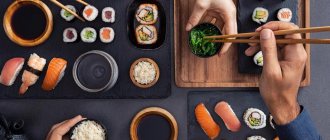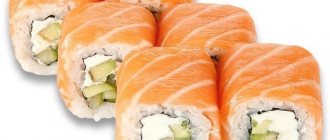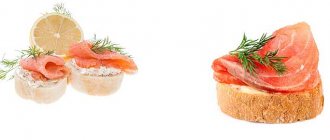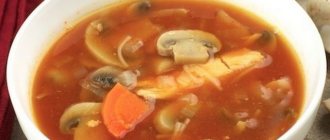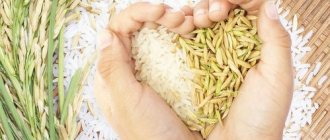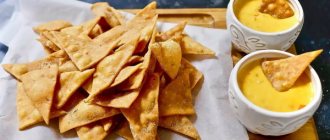Nutritional and energy value:
| Ready meals | |||
| kcal 751.2 kcal | proteins 29 g | fat 7.3 g | carbohydrates 150.5 g |
| Portions | |||
| kcal 375.6 kcal | proteins 14.5 g | fat 3.7 g | carbohydrates 75.3 g |
| 100 g dish | |||
| kcal 170.7 kcal | proteins 6.6 g | fat 1.7 g | carbohydrates 34.2 g |
Is sushi and rolls a dietary food or not, is it possible to have them with PP?
Judging by the appearance of the Japanese, and among them there are rarely overweight people, we can safely say that sushi and rolls are a real godsend for dieters. In Japan, a fat person is truly a rarity and this is largely due to diet. The presence of a large number of vegetables and seafood on the menu makes the diet healthy and correct. But is everything really so rosy and is it possible to eat all sushi and rolls indiscriminately? Of course no.
If you adhere to proper nutrition, then you must follow some rules when eating Japanese cuisine:
- Avoid rolls with a lot of cheese and mayonnaise. The cream cheese contained in the rolls significantly increases the calorie content of this product, and mayonnaise even more so.
- do not overuse sauces and other additives. It is important to remember that any sauces are a source of empty calories. They will not bring satiation, and in some cases, even on the contrary, they will increase your appetite. This is especially true for hot sauces.
- Choose sushi that has a lot of vegetables - avocado, zucchini, cucumber. They contain the least calories. So, zucchini rolls contain about 80 calories per 100 grams and can be safely included in your diet.
- give preference not to smoked fish, but to fresh or lightly salted fish. Any smoked meats retain liquid very strongly, so if you don’t want to wake up tomorrow with swelling and weight gain on the scales, then it’s better to avoid smoked meats.
- soy sauce carries the same danger - swelling, do not abuse it by mercilessly pouring it over your rolls or sushi.
- Skip the tempura. This is a special type of roll, which is fried in batter in a large amount of vegetable oil. And since the oil has the ability to be absorbed perfectly, the calorie content of such rolls increases sharply.
These rules should be followed if you order rolls or sushi in a restaurant.
If you decide to make pp rolls at home, then you need to know the following subtleties and secrets:
- If you really love rice and are not ready to give it up, then you can always use brown rice instead of regular white rice. It contains many times more nutrients and fiber, which the body needs for cleansing.
- A layer of omelette will help replace a layer of rice. You can cook an omelette using only whites, then you will also have a protein product. And if you want even more benefits, you can mix the protein with cottage cheese.
- Instead of full-fat cream cheese, use low-fat cream cheese or low-fat cream cheese. This way you can easily reduce the calorie content of the finished dish.
- cook nori with vegetables. You don’t have to put rice in these rolls at all, so the calorie content will be minimal.
- make low-calorie sauces for your rolls. Instead of mayonnaise, you can always prepare pp mayonnaise based on natural yogurt.
What products are Japanese dishes made from?
The main ingredient of rolls is rice. Properly prepared, it allows the body to quickly get enough. It contains carbohydrates and fiber - microelements vital for every person.
Fresh, smoked and salted fish, which is also one of the components of a complete Japanese dish, gives sushi a special taste. The freshness of the entire dish depends on the quality of the fish. Professional chefs - specialists in making sushi - know how to combine ingredients in such a way as to achieve the highest taste harmony. Rolls with salmon, tuna and eel are quite popular in Japanese restaurants; they are very nutritious, but low in calories.
Seafood, which is also indispensable during the cooking process, must be fresh and added to the rice in a certain quantity.
Vegetables, seaweed and seasonings play a special role in making sushi. Some of these ingredients add piquancy to the dish, while others are added to enhance or subdue the unusual flavor of the fish or seafood. The most popular vegetarian dish is rolls with avocado and cucumber.
Diet rolls at home
So, if you really want pp rolls on a diet, you can always prepare an exclusively dietary version. To do this you will need:
- 200 grams of cottage cheese. We will use this product instead of rice. This way you will immediately make pp rolls less calorie and also add protein to your diet.
- Natural yogurt. We will season the cottage cheese with it. A couple of tablespoons will be enough.
- 1 cucumber. You can use zucchini instead of cucumber. Wash and cut into strips.
- 100 grams of fish. If you use salted fish, it is better that it be lightly salted fish.
- Nori leaves. We will wrap the pp rolls in nori leaves. You will need 2 sheets. We cut each sheet into two parts, this will make it easier to wrap the pp rolls.
First, mix cottage cheese with yogurt. If desired, you can add any greens to the curd mixture.
Place the curd mixture on a sheet of nori and place fish and cucumber on top. Let's wrap it up.
How to cook
1. Boil or fry chicken fillet without oil. Let cool and cut into strips.
2. Cut the cucumber into strips.
3. Mix cottage cheese with yogurt, salt and spices.
4. Disassemble the cabbage into sheets. Coat each sheet with the curd mixture. Place strips of chicken and cucumber in the middle. Roll up the roll.
5. Place in the refrigerator for 20-30 minutes. Then cut into equal parts.
The recipe for “Protein rolls” is ready, bon appetit
